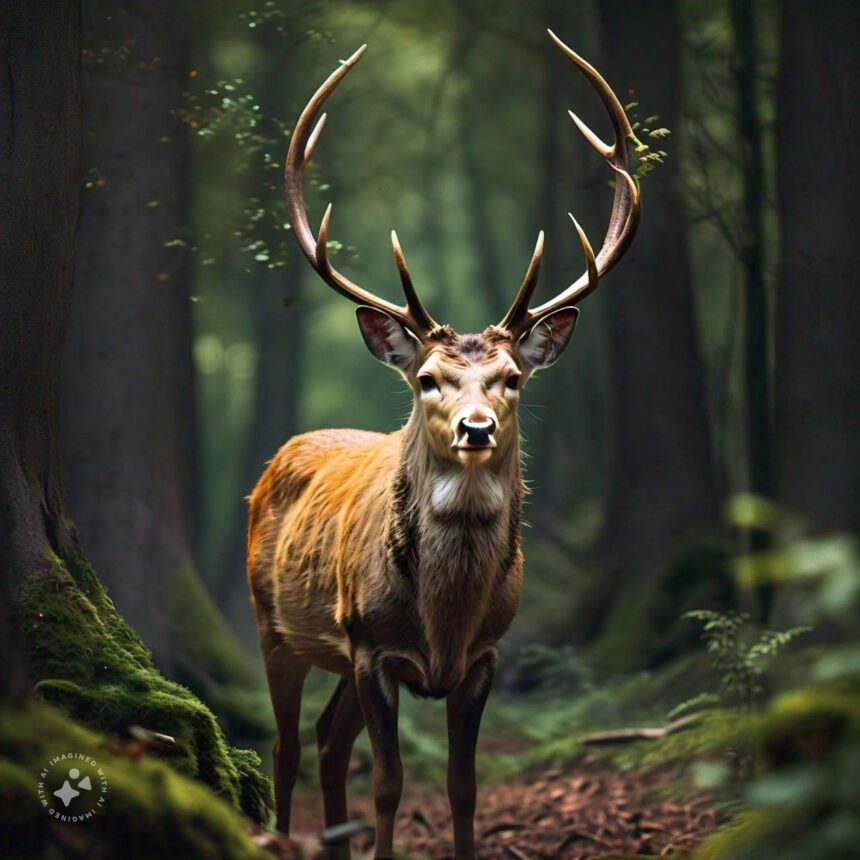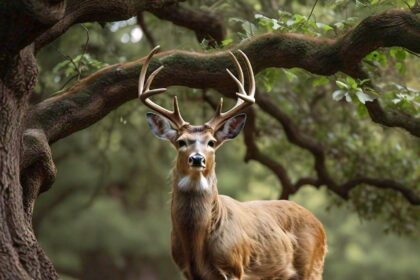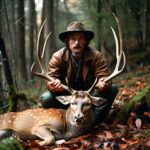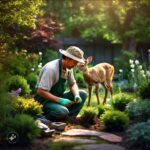Are you ready for an exciting adventure of watching deer in the wild? Watching deer lets nature lovers connect with these beautiful creatures in their natural setting.
Whether you’re experienced or just starting, learning how to stalk deer can lead to amazing moments.
Picture being just yards away from a beautiful whitetail deer, watching it without scaring it. This is possible! With the right skills and knowledge of deer behavior, you can encounter deer without scaring them.
By learning about their favorite spots and daily routines, you can learn how to keep your distance and enjoy successful deer sightings.
Are you ready to explore deer watching? Let’s look at the key skills and knowledge you need for a successful nature trip. Get ready to improve your senses and enter the world of these gentle forest animals.
Understanding Deer Behavior and Habitat
To spot and track deer, knowing their habitats and behavior is key. You should know that deer have unique traits that shape their daily lives and seasonal movements.
Let’s dive into the world of deer and learn the top tips to observe them better.
Common Deer Species and Their Characteristics
There are 43 deer species, and 42 have males with antlers. The Chinese water deer is the only one without a set of antlers. Antlers grow for about 150 days and are used for fighting and attracting mates. After mating, most deer lose their antlers, but some in the tropics keep them.
Big deer- especially mature bucks, need more food for their antlers, which helps them live in areas where forests and fields meet. Swamps are also a favorite spot, despite the dangers from predators like alligators. Deer can swim well, which helps them in wet areas.
Daily and Seasonal Patterns of Deer Activity
Deer are cautious animals and so act differently based on their surroundings. The W.M.W.M. Study showed that temperature affects how much they move, with less activity in extreme heat or cold. Changes in barometric pressure also matter a lot.
The best time of day for deer to move is mostly when the pressure is between 29.90 and 30.30 inches, especially if it’s dropping fast. This helps them get ready for the weather to come.
“Mother Nature’s way of protecting the herd is through their response to barometric pressure changes.”
Knowing these patterns can help you spot and track them better, positively affecting your overall goal of watching deer in the wild. You should also remember that, it is also important to manage deer and their homes, like wetlands, for their survival.
Choosing the Perfect Location for Watching Deer In The Wild
Want to really enjoy your experience of watching deer in the wild? You should know what to look for! Finding the right spot is crucial for spotting deer. Look for places with both cover and open areas. We’ll look into how to discover these ideal spots.
Identifying Ideal Deer Tracking Spots
Search for these features:
- Edge habitats where forests meet fields
- Water sources like creeks or ponds
- Oak trees dropping acorns in fall
- Well-worn trails with fresh tracks
- Bedding areas in dense cover
Using Satellite Imagery to Scout Locations
Satellite maps are useful for finding deer habitats. They show:
- Forested areas next to open fields
- Ridge lines that deer use for bedding
- Natural funnels that concentrate deer movement
Importance of Accessible Areas with Ample Edge Habitat
Pick spots you can easily get to. This makes exploring and learning about deer easier. Edge habitats are perfect for deer watching. They offer food, water, and shelter in one spot.
“The best deer habitats are like a buffet and a bedroom combined. Find these, and you’ll find deer.”
Many deer populations may change habits with the seasons. In early fall, focus on food sources. During the rut, look for travel corridors. In winter, deer stay near bedding and feeding spots. Knowing these patterns helps you see deer more easily.
Watching Deer in the Wild: Essential Techniques
Just like deer hunting, learning to spot deer takes time and patience. It’s important to know their behavior and use the right methods. Field guides help, but nothing beats real-world experience.
The “stalk walk” is key for spotting deer. Beware of soft ground, move slowly and carefully, stopping to look around often. Use trees or bushes to hide your outline. Remember, the wind direction can help you stay quiet and avoid scaring the deer.
Being aware of sounds is crucial. Learn to move quietly in different places. Sometimes, crawling is needed if you want to take a closer look without being seen. Listen for birds or other animals that might mean deer are nearby.
- Use binoculars or spotting scopes for distant observation
- Practice moving silently through various terrains
- Learn to interpret animal behaviors indicating deer presence
- Utilize natural cover to mask your movements
Each deer type is different. Red deer, the biggest in Britain, can weigh up to 240kg. Fallow deer have four colors: tan, menil, melanistic, and white. Muntjac, the smallest, leave tiny 3cm long tracks.
During breeding season (the rut activity), which starts mid-September for red deer, keep a safe distance. A 300mm lens is best for photos, keeping at least 150 meters away from the deer. Always be alert and respect these wild animals in their home.
Recognizing Signs of Deer Presence
In other not to draw attention which will attract deer, you need skill and patience. You must know what signs to look for. Deer tracking is more than just following footprints.
To master the skill of watching deer in the wild, you need to understand their behavior and use field guides to read their clues.
Identifying Deer Tracks and Trails
Deer may leave tracks, this can reveal a lot about the animal. Fawns have smaller prints than roe deer, who also have even smaller prints than a stag.
Look for heart-shaped hoof prints in soft soil or mud. Deer often follow the same paths, making trails through the vegetation.
Spotting Deer Beds and Feeding Areas
Deer beds are oval or kidney-bean shaped, where they rest. Buck beds are usually alone, but does may bed with their fawns. Feeding areas show browsed vegetation with torn fibers on branches.
These feeding areas can also be found in agricultural fields and forest edges, especially at dawn and dusk.
Interpreting Deer Vocalizations and Body Language
Understanding deer communication helps predict their behavior. They make various calls, from soft grunts to loud snorts. Their body language is also telling. A relaxed deer will casually scan its surroundings, while an alert deer will focus on a threat.
“A deer’s sense of smell is estimated to be 10,000 times stronger than a human’s.”
Deer rely on their keen senses. Deer can also see nine times better in low light and have a wider view than humans. Their hearing is great, with ears that move to locate sounds. But their smell is their most impressive sense, helping them understand their environment and threats.
- Look for rubs on trees, which bucks use to mark territory
- Check for scrapes on the ground, used for scent communication
- Observe other wildlife, as their behavior can indicate deer presence
By improving your observation skills and using these tracking techniques, you’ll increase your chances of seeing these beautiful creatures in the wild at close proximity.
Conclusion: Embrace the Thrill of Watching Deer In The Wild
Starting your wildlife observation journey opens up more than just a hobby. It’s a way to connect with the world around us. By learning to track, be quiet, and understand animal behavior, you’ll feel closer to nature.
For nature lovers, you can do more than just watch. You can help protect deer by joining science projects or supporting wildlife groups. These efforts protect deer and teach us to care for our planet. Recent research shows there are over 125,000 Axis Deer in Texas alone.
Always watch wildlife from a distance and don’t disturb their homes. Never feed them. This way, you help make sure future generations can also enjoy watching these amazing animals. So, take your binoculars and explore the world of deer and other wild animals.








